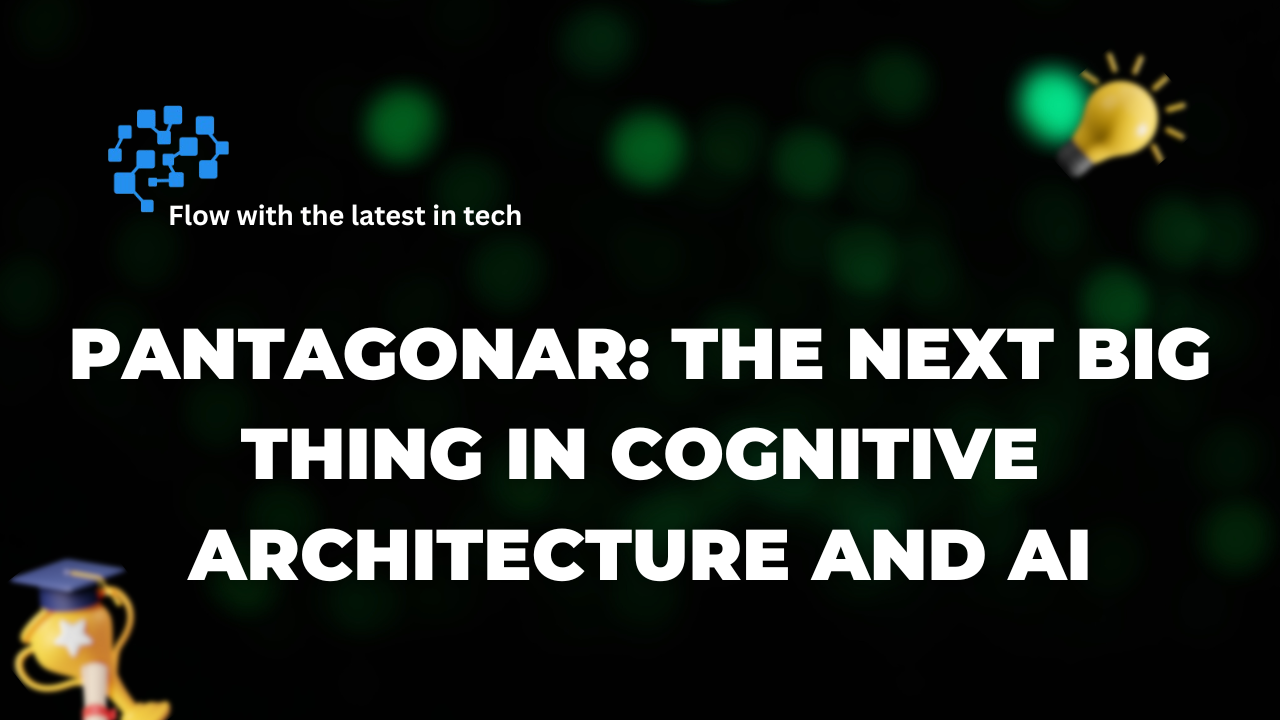Table of Contents
Beginning
In the unending quest for artificial intelligence that imitates and possibly exceeds human cognitive functions we have observed a succession of paradigms ranging from expert systems and neural networks to extensive language models. But there is still a big problem: these systems don’t always have a deep structured and dynamic understanding of the world and thus have trouble with real reasoning common sense and adapting to different situations. In cognitive architecture and AI design Pantagonar is a new but innovative theoretical framework. The word itself brings to mind a shape with five angles which suggests a way of processing information that is not limited to one dimension. You can’t download Pantagonar as a single product. Instead, it’s a plan on how to build AI that thinks more like we do. This blog post will go into great detail about this interesting idea. We will look into what Pantagonar is why it could change the way we think about things how it might work and its big pros and cons in an objective way.
What is Pantagonar?
At its core Pantagonar is a suggested way for artificial general intelligence (AGI) to think. The word is a portmanteau that combines “penta” (five) and “agon” battle or in this case process for perception and reasoning. It goes beyond the statistical pattern-matching of contemporary AI and instead builds and changes a rich internal world model.
Most modern AIs are very smart and have learned a lot on their own by reading a lot of the internet. They can write something that is statistically likely but they don’t really get it. They don’t have a stable way of seeing the world within their heads. Pantagonar wants to make an AI that doesn’t just handle data but also thinks about it and experiences it.
People think the “Five Facets” of the Pantagonar architecture are:
Perceptual Grounding: This part changes raw sensory information including text images and sound) into symbols that have meaning. It doesn’t simply see pixels; it sees objects relationships and activities and puts them in a basic context.
Episodic Memory: Pantagonar would not store information as separate facts but as sequential contextual episodes. This lets it remember not only what happened but also when in what sequence and under what conditions.
Semantic Network: This is a web of knowledge that is always changing and interrelated. “Rain” “umbrella” “wet” and “cancelled” are all related to one other in terms of their meanings and how they work together (for example “rain causes wet” “umbrella prevents wet” and “wet can lead to cancelled picnic”).
This part of the procedural engine handles the “how-to” information. It has instructions for doing things from the easy (how to break down a sentence) to the hard (how to make a plan with many steps to reach a goal).
The Meta-Cognitive Governor is the most advanced part of the system. It is what makes the system aware of itself and gives it executive authority. It keeps an eye on the other four aspects decides how to use computing resources checks the success of its own reasoning and chooses when to learn new techniques or change its aims.
What makes Pantagonar a good idea right now?
The AI community is starting to see that scaling alone isn’t enough. Making models bigger and training them on more data doesn’t help them grasp things better. Theoretical attractiveness of Pantagonar comes from how it directly deals with these main problems.
The Common Sense Problem: AIs today are well-known for not having common sense. They can’t figure out that putting a laptop in a blender will probably break it. Theoretically Pantagonar may reject such absurdities because its world model would know that blenders break electronics.
Neural networks are frequently quite fragile meaning that even a small change in the input can cause the output to be utterly inaccurate and make no sense. Pantagonar’s hierarchical symbolic basis would provide it more stability and strength than plain statistical models.
The Need for Explainable AI (XAI): The “black box” problem makes it hard to use AI in important areas like medicine and finance. Since Pantagonar would utilize a structured world model to think it could in theory go back through its reasoning steps and give a clear human readable explanation for its results.
The Quest for Continuous Learning: Many current models have a problem called “catastrophic forgetting” which means that learning new things overwrites what you already know. Pantagonar’s architecture has separate but connected parts for memory and knowledge. This lets, it add new experiences to its present structure without messing up what it already knows.
Going Beyond Pattern thinking over Recognition: Pantagonar is primarily intended for thinking rather than mere recognition. It would be able to use abductive and counterfactual reasoning which means it could figure out what might have happened if something else had happened. This is an important skill for scientific discovery and planning.
How Would a Pantagonar System Function?
Building Pantagonar would be a huge task for software engineers and AI. You can think of how it works as a never ending changing cycle:
Step 1: Getting Grounded and Seeing
A Pantagonar-based agent like a robot sees a red ball on a table.
The Perceptual Grounding part examines the visual information to find the objects (“red ball,” “table”) and how they are related in space (“ball is on table”). It turns this raw data into symbolic statements.
Step 2: Putting things together and making memories
The architecture includes this new experience.
The Episodic Memory keeps track of the event: “At time T I saw a ball on the table.”
The Semantic Network gets new information or is strengthened. The words “ball” “red” “on” and “table” are more closely related. It gets information that is linked like “balls are round” “balls can roll” and “tables are surfaces.”
Step 3: Thinking and Making Plans
Move the ball to the floor is an order.
The Procedural Engine has been turned on. It asks the Semantic Network how to “move” an object. It comes up with a plan:
1. Find the ball.
2. Hold the ball.
3. Move your arm to the floor.
4. Let go of the ball.
The Meta-Cognitive Governor is in charge of this planning. They make sure that the steps make sense and are possible given the condition of the world model right now.
Step 4: Do something and learn
The robot follows the plan. If it works the Procedural Memory gets stronger. If it doesn’t work, such if the ball is too slippery the failure is recorded as a new episode. The Meta-Cognitive Governor makes me rethink things: “My method for grabbing smooth spheres isn’t good enough.” I need to make it better. This results in new knowledge, which is subsequently incorporated into the pertinent aspects.
The Good Things About the Pantagonar Approach
Strong Common Sense Reasoning: Its structured knowledge base would make it less likely to make the silly mistakes that are typical in LLMs today.
Explainability and Transparency: The decision-making process would be clear since you could see how it worked by changing the symbols and the semantic network. This would make it a “glass box” instead of a black box.
Efficient and Continuous Learning: It might learn from just one example one-shot learning by adding it to its world model. Neural networks on the other hand need huge datasets to learn. It would also be much less likely to forget things that are very important.
Generalization and Transfer Learning: A Pantagonar system with a well-structured world model could use knowledge from one area to solve a new problem far better than a specialized AI could.
True Causal Understanding: It would be able to comprehend how things are related to each other which would let it make predictions and take action in the real world in ways that pattern-matchers can’t.
The Problems and Difficulties
The Issue of Symbol Grounding: A classic problem in AI is how to make sure that the symbols in the system such “red” and “ball” really mean the same thing as the things they stand for in the real world. This is a basic philosophical and technical problem.
Huge computational complexity: To make keep and update in real time such a rich interconnected world model you would need a lot more computing power than what today’s neural networks demand.
Engineering Knowledge Bottleneck: How do you start building the huge semantic network and procedural knowledge? It is impossible to code it by hand. Pantagonar’s goal is to figure out how to learn everything from data which is an issue that makes things even more complicated.
Integration with Sub-symbolic Processing: The world is always changing and messy. Pure symbolic systems have a hard time with perception. For perception and low-level control a successful Pantagonar architecture would need to combine its symbolic reasoning with the sub symbolic statistical capacity of neural networks in a way that is not easy to do.
The Frame Problem: How does the system figure out which facts are important and which ones it may ignore? It’s impossible to update a huge global model every time something small changes in the environment.
Important Things for Success
For Pantagonar to go from being a theory to being real a few important things need to be taken care of:
Hybrid Symbolic-Subsymbolic Design: It can’t only be a symbolic system. It will only succeed if it has a beautiful and efficient hybrid design that employs neural networks for sensing and grounding and symbolic reasoning for higher level thinking.
Scalable World Model Representation: It is important to provide a data structure and algorithms that can represent a huge changing world model without making the calculations too hard.
Developmental Learning Pathway: You can’t start the system up with a complete world model. It must be built to learn like a toddler starting with easy ideas and interactions and getting more complicated over time based on what it has “experienced.”
Resource Allocation and Attention Mechanism: The Meta-Cognitive Governor needs advanced algorithms to direct the system’s limited computational resources to the most important parts of a task which is how the frame problem is really solved.
Open collaborative research: No one group can handle this problem on its own. Progress will probably depend on a collaborative open-source research project like Linux or the early days of the internet.
Final Thoughts
Pantagonar is a brave and thought-provoking concept for the future of AI. It is a call to go beyond just making statistical models bigger and instead build systems that have a deep structured, and useful grasp of the world. Even though it is still just a theory its ideas deal with the biggest problems with modern AI: it doesn’t have common sense it’s hard to understand and it’s fragile.
There are huge problems to overcome on the way to developing a real Pantagonar architecture both philosophical and computational. The final implementation might not look like the five-part architecture suggested above. It might become a more integrated or complicated structure.
But the main point of Pantagonar that intelligence needs a deep internal world model is true. Pantagonar has already become an important north star on the path to making machines that don’t just calculate but really understand. It could be the basis for the first AGI or a key step that leads to the next paradigm.

